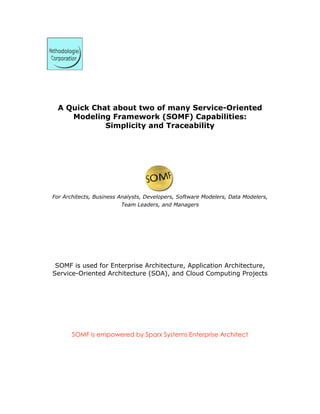SOMF Capabilities - Quick Chat
•
0 likes•445 views
Quick Chat about SOMF Simplicity and Traceability Capabilities
Report
Share
Report
Share
Download to read offline

Recommended
Recommended
More Related Content
Similar to SOMF Capabilities - Quick Chat
Similar to SOMF Capabilities - Quick Chat (20)
Interface characteristics - Kim Clark and Brian Petrini

Interface characteristics - Kim Clark and Brian Petrini
Oracle AIA - Does it deliver on it's integration promise?

Oracle AIA - Does it deliver on it's integration promise?
Evolution of Modelling Techniques for Service Oriented Architecture

Evolution of Modelling Techniques for Service Oriented Architecture
PURPOSE of the project is Williams Specialty Company (WSC) reque.docx

PURPOSE of the project is Williams Specialty Company (WSC) reque.docx
Task 2 - Educational Article – Model View Controller (MVC)

Task 2 - Educational Article – Model View Controller (MVC)
SOMF Capabilities - Quick Chat
- 1. A Quick Chat about two of many Service-Oriented Modeling Framework (SOMF) Capabilities: Simplicity and Traceability For Architects, Business Analysts, Developers, Software Modelers, Data Modelers, Team Leaders, and Managers SOMF is used for Enterprise Architecture, Application Architecture, Service-Oriented Architecture (SOA), and Cloud Computing Projects SOMF is empowered by Sparx Systems Enterprise Architect
- 2. Simplicity Think about how often we try to explain in simple words how a software entity is linked to another, describe dependencies of one component on others, or illustrate the affiliation between applications in a production environment. So, here is how the service-oriented modeling framework (SOMF) advocates expressing coupling between two software entities: Easy? Yes, this is simple because SOMF both promotes simplicity and enables architects, managers, analysts, modelers, and developers to communicate by employing a simple language. In this case, we use the “Coupled” symbol to indicate software coupling. Another example: How can we describe the containment of one software component within another? This is simple to illustrate. See the example below:
- 3. In the above example, Component 2 (parent) aggregates component 2.1 (child) by using the “Aggregated” symbol. Note that the plus sign that is enclosed in a circle points to the parent component – Component 2. And how do we separate an aggregated entity? This is also simple to illustrate. In the above diagram Component 2.1 (child) is separated from its parent aggregating entity by employing the “Decoupled” symbol. Again, note that the fork-like symbol points to the parent Component 2. Finally, how do we signify a binding contract between a service provider and its corresponding consumer? This is really easy to do. See the below diagram that is employing the “Bound” symbol to tie two software entities (Component 1 and Component 2) by a stipulated contract.
- 5. Traceability Next, if you want to illustrate past relationships between two software pieces employ the SOMF “Decoupled” symbol, just a you see in the below diagram. Traceability of software architecture is the reason. In this case, SOMF calls for preserving past implementation decisions and allows traceability of architecture best practices and even expenditure. So let us take a look at an architecture traceability example below. Here the reason for separating Component 1 (child) from its parent Component 2 is indicated in the comment box: “Architecture Best Practice: Component 2 is too coarse-grained”. Component 2.1, however, is still aggregated in its parent Component 2.
- 6. Business traceability can also be expressed by employing this method. Note that the below diagram indicates that the cost of software entity separation is $5,000.
- 7. To learn more about many SOMF capabilities, modeling methods and formal notation, and patterns for enterprise architecture, service- oriented architecture (SOA), and Cloud Computing refer to these books: